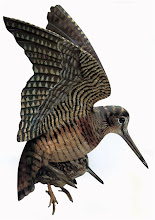
In our third project, in 2008, we deal with two prototypes given by MTI.
The PTTs have a special duty cycle of 55/8. One of the main aims of this project is to see the performance of the new PTTs against the European interferences. Another one, of course, is to know the migration of two Eurasian woodcocks: Araba and Laguna.
On March 8th, 2008, Laguna was caught in Legutio (Araba, Basque Country). After the emission of September 24th, Laguna gave no more datum. Laguna’s whole track is around 3,710 km. Laguna has gone up to the surroundings of Elizarovo, in Kostroma.
On December 27th Laguna was hunted at Legutio, at 454 meters from his release point. So, Laguna has become an iron woodcock. He has been able to come back to the same place where we caught him, crossing Europe while the hunting period was open. All in all, his whole track has been around 7,420 km.
On March 10th, 2008, Araba was caught in Lukiano (Araba, Basque Country). From September 14th on, in all the different emissions the activity sensor has not changed: Araba is dead and/or his PTT is detached. Araba’s whole track is around 3,280 km. Araba has gone up to the surroundings of Rantala, Republic of Karelia.
The final result is net: the European interferences have been overcome with both PTTs, during all the time the tracking lasted and in all the different atmospheric circumstances.
For more information, see Scolopax rusticola without frontiers: http://www.euskonews.com/0522zbk/gaia52202en.html and
http://es.scribd.com/doc/58456338/Scolopax-rusticola-without-frontiers.
Note: Araba’s PTT was recovered in Rantala, region of Suojarvi, Karelia in September 2009. See The recovery of Araba’s PTT in Karelia: http://es.scribd.com/doc/58456686/The-Recovery-of-Araba-s-PTT-in-Karelia.
